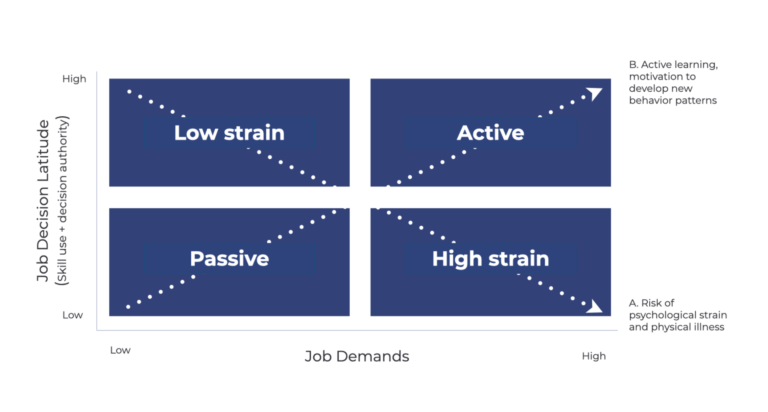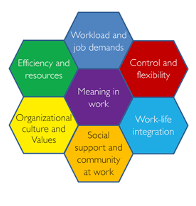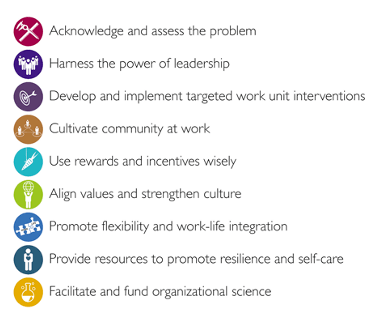
Managing Burnout — Part Three: Organizational Determinants of Health
In today’s blog, Part 3 of this Burnout series, I will explore how Organizational Determinants of Health impact burnout and wellbeing, as well as how employers can make a difference with some evidence-based tips for leaders and organizations.
Why we can’t change some of the root causes of burnout without changing work culture and practices!
In the Part 1 and Part 2 blogs of this three-part Burnout series, I shared insights around the mechanisms of burnout, strategies to reduce the risk of burnout, and specific environmental factors that impact resilience. As a recap, I introduced three groupings in order to better understand various risks as well as approaches to reduce or mitigate risk. These groupings are:
- PDOH: Personal Determinants of Health
- SDOH: Social Determinants of Health
- ODOH: Organizational Determinants of Health
In today’s blog, I will focus on the Organizational Determinants of Health and their impact on burnout and mental wellbeing1. Just as personal and social pressures impact our risk for burnout, the organizations in which we work play a significant role.
Many organizations operate under the framework that the responsibility of preventing burnout falls on each individual employee. While company-offered resilience programs can help mitigate and prevent some burnout, they will not eradicate the prevalence of burnout, which will continue to grow if organizational root causes are not addressed.
The Job-Demand-Control-Support model demonstrates how job characteristics influence employees’ psychological wellbeing. The model illustrates how job demands, such as heavy workload, role ambiguity, and job-related strain, are the risks that can cause stress for employees. Interestingly, in the short term, with appropriate recovery, these risks can lead to growth as opposed to distress. The model also shows how individuals can manage these risks through autonomy and control over their work as well as developing strong relationships with their work colleagues and managers
Figure 1. Job Demand Control Model

Job Demand-Psychological workload
- time pressure
- role conflict
- quantity of work
Job Control-Decision latitude
- Freedom to control and plan work activities
- Skill discretion and decision authority
- Psychological and instrumental help and support from work environment.


Kumanu’s work looking at how burnout risk and purpose are connected demonstrates some additional areas to consider.
Fundamental to burnout risk is the employee’s ability to regulate emotion. Working with Dr. Ethan Kross, a psychologist and Director of the Emotions and Self Control Lab at the University of Michigan, we’ve identified a pathway that begins with what we call “purposeful culture.”
An index of purposeful culture includes five dimensions:
- Does the employee feel their organization tries to understand and support their purpose for working?
- Does the employee feel their organization has a higher, revenue-transcending purpose?
- Does the employee feel dignity and that they belong in the organization?
- Does the employee identify with the organization?
- Does the employee feel that their work helps to fulfill their life purpose?
A high purposeful culture index is associated with a strong purpose in life which, in turn, is associated with use of effective coping strategies that create greater emotional self-regulation. Coping strategies such as “seeing the big picture,” “engaging in family and/or religious rituals,” “engaging in nature” are strategies successfully used by purposeful people.
Leaders and frontline managers can help to create elements of purposeful work culture that can translate to increased feelings of purpose in life.
Here are some actions they can take:
- Look for signs of burnout
- Be an empathetic leader
- Foster better communication
- Encourage recovery or “downtime”
- Celebrate employees and life outside the workplace
Look for signs of burnout
Managing stress is essential for supporting mental health and avoiding burnout. Eight out of ten employees report feeling stressed at work. However, stress is not inherently bad. Employers should acknowledge the difference between pressure and stress. Pressure is unavoidable and it is this pressure that often allows us to grow, stay motivated, and achieve our goals. Stress, on the other hand, is what happens when the pressure becomes excessive or exceeds our capacity, and is followed by inadequate recovery. This can lead to a negative impact on both health and performance.
People need time to recover from the pressure that can come with many types of work. When there isn’t enough time to recover, exhaustion, burnout, and mental health challenges can follow. Managers should routinely check in with employees to find out how their workload is going and ask them what they can do to help them feel supported, help mitigate employee burnout, boost engagement, and strengthen organizational resiliency.
Be an empathetic leader
The ability to listen and respond with empathy is highly correlated with key management skills, including being more engaged, coaching, and making sound decisions. In fact, research has found that companies who focus on empathy within the organization have, on average, a 400% higher stock price. Understanding the needs of other people is at the heart of empathy. Managers can best serve their teams when they demonstrate an awareness that employees’ thoughts, feelings and overall wellbeing are influenced by a complex set of factors, including their background and everyday environment. Simply put, leaders can show empathy by understanding their employee’s social determinants of health.
Foster better communication
Communication is essential to understanding your employees’ needs, and challenges. Especially in hybrid work environments, more frequent and consistent opportunities for authentic conversations are important to not only promote greater trust and understanding but to avoid feelings of isolation. Talk openly about mental wellbeing and stressors in your organization. Model openness and share your own vulnerabilities.
Recognize the importance of taking care of ourselves and supporting each other. Share insights such as “I know when I’m not managing pressures and stress as I don’t sleep very well, I’m short tempered, or become distracted and withdrawn.“ Being explicitly open about these issues encourages a climate of trust and helps to avoid a culture where people don’t want to share.
Encourage recovery or “downtime”
Model behavior that lets employees know that they can and should take breaks, personal days, or vacation when necessary.
Encourage employees to put away their devices when they are “off the clock.” Help create an understanding that setting boundaries between their professional and personal lives is welcome. Ensure your leadership style is supportive of your employee’s finding their own authentic work life balance. Be explicit to calibrate expectations.
Many companies are adopting flexible PTO programs that enable employees to take time off according to their needs. Even a few mini-breaks throughout the day can significantly boost wellbeing and productivity. Make it clear that team members are not expected to check their email while taking vacation time. If they are essential, find someone to cover for them. Vacations are for recharging.
Celebrate employees and life outside the workplace
As crucial as it is to support employees when they struggle, it’s just as vital to celebrate their wins. When employees are empowered to share both their professional and personal successes — whether it’s a promotion or completing a marathon — they feel valued as human beings, not just employees.
An SHRM/Work survey found that employees are 64% more likely to say their company is a good place to work if they are very or somewhat satisfied with how life events are celebrated. Ultimately, companies that encourage a positive community experience around employees’ lives give them the confidence to express their full, diverse selves, and can create an environment that supports positive mental health outcomes.
The workplace is a critical factor in mental health and, ideally, a rich resource for information, resources, and support. Yet it’s also just one point in the broader constellation of social and environmental factors that shape each person’s life and health. For employers, the goal should be to understand and be sensitive to these other factors — and then build support that addresses common needs and makes the workplace a positive catalyst for mental health.
The good news is, burnout is preventable. With strong manager support and an understanding of what causes burnout, organizations can more readily monitor, engage with their teams, incorporate digital solutions, and promote proven mitigation strategies, all with the goal of prevention.
1 Häusser, J. A., Mojzisch, A., Niesel, M., & Schulz-Hardt, S. (2010). Ten years on: A review of recent research on the Job Demand–Control (-Support) model and psychological well-being. Work & Stress, 24(1), 1-35.
2 Mayo Clin Proc., January 2017;92(1):129-146 http://dx.doi.org/10.1016/j.mayocp.2016.10.004 www.mayoclinicproceedings.org
About the Author

Robert Carr, MD, MPH, FACPM
Chief Medical Officer
Robert Carr was most recently Senior Vice President & Corporate Medical Director at GlaxoSmithKline and on the faculty at Georgetown University. He received his Doctor of Medicine from the University of Miami School of Medicine and his Masters of Public Health and Preventive Medicine Residency from the John Hopkins Bloomberg School of Hygiene and Public Health. Bob also served as the President of the American College of Preventive Medicine
Stay on top of the news
Subscribe today and receive our Reimagining Wellbeing newsletter delivered to your inbox every month!
